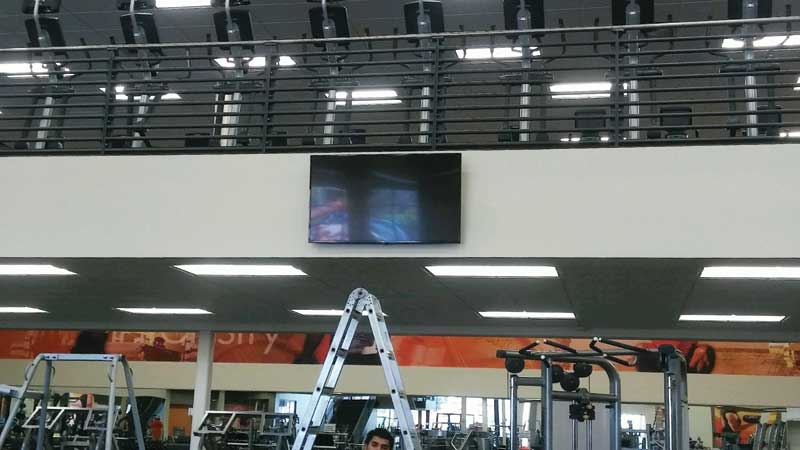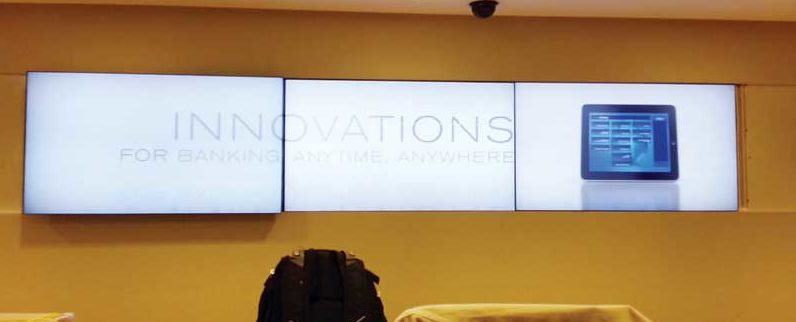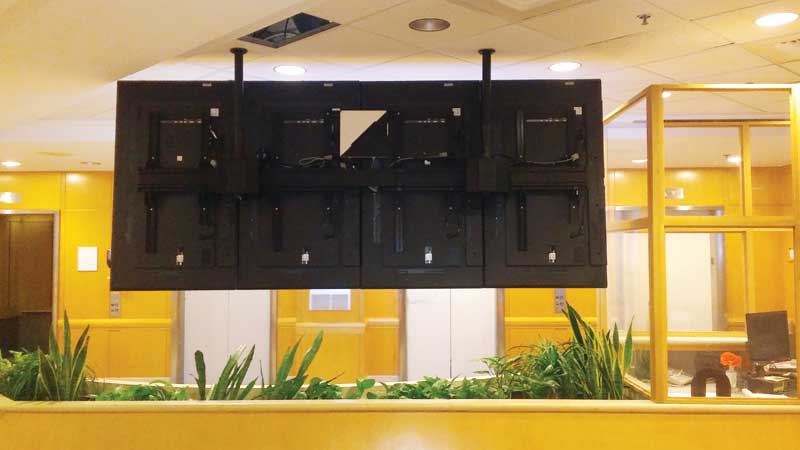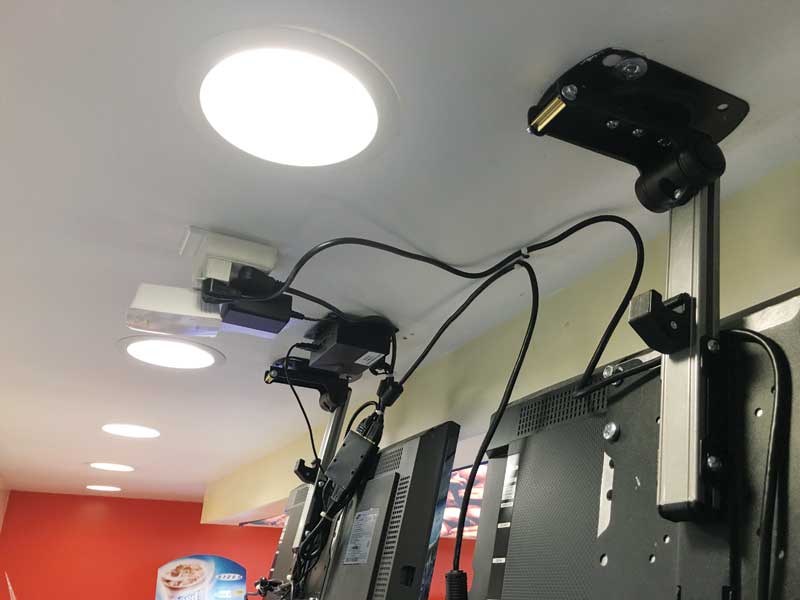Digital Signage: The logistics of network installation
by all | 15 September 2016 10:14 am

Photos courtesy iTeam
By William Kazman and Paul Gilmartin
Installing digital signage involves the logistics of getting everything in the right place at the right time. Every project starts out with a test of one screen in one location, but many projects fail at this pilot stage because of poor installation development, at which point there is often no patience to move forward. This is especially true when digital signage is driven by marketing interests but without the support of an organization’s information technology (IT) department.
There are many elements involved in deploying, maintaining, servicing and supporting a digital signage network and it is important to understand all of the implications of the medium. Managing risk in a digital signage rollout involves anticipation, planning, clear communications and a well-thought-out process.
Different approaches
There are different ways for digital signage providers to handle rollouts and support. One is to rely on in-house resources. This option ensures direct control and, depending on the situation, may reduce costs. It also carries relatively hefty requirements in terms of skill, reach and timing. Focusing on a complex installation, for example, can easily have a negative impact on other projects.
Another option is to hire a local subcontractor. The expenses may include administrative and management fees, but typically the labour costs are relatively low. Concerns can include a lack of predictability, visibility and quality control.
A third option is to hire a professional digital signage installation company. Direct control is again abandoned, but there are gains in terms of speed, scale, predictable costs and quality, visibility and specialized skills.
Traditional sign shops may already have the customer base for digital signage installations, which gives them a big leg up in the market, but they may find it challenging to provide an effective service offering. The answer to this challenge, generally, is to partner with other companies accordingly.

Ladders, lifts, poles and other hardware may be needed to reach the mounting location.
Surveying the site
While there is a push to diversify digital signage through interactivity, integration with mobile communications and camera-based analytics, the underlying structural realities are the same, no matter the screens. These include mounting hardware for physically holding the screens in place, software for managing content, media players—either built into or connected to the screens—and monitoring systems.
When determining where to install digital signage displays, it is important to consider esthetics, traffic and sightlines. Physical factors to account for may include the locations and rigidity of metal wall studs, the structural integrity of the wall, the thickness of the ceiling and hidden obstructions, whether electrical, plumbing-related or other. Safety will depend on clearance and how securely the screens can be mounted. Displays have become lighter and easier to handle, but they can still be quite fragile during installation.
With these factors in mind, a site survey in advance is always a good idea. The screen size and project budget will help determine which mounting locations are actually possible, not simply desired by the client. There may well be tradeoffs before the final mounting locations are chosen.
There are many installation options for screens, including fixed, tilt, swing, pullout, ceiling, wall, cart, stand, truss and pole mounts. For a wall mount, the site survey should check the material (drywall, cement, metal, wood, brick, stone, tile, etc.) and its structural integrity, along with spacing and alignment with relation to the desired target audience’s location.
Similarly, ceilings can vary widely, including drop ceilings, drywall, wooden beams and concrete. I-beams and bar joists will affect the choice of mounting location, as can the distance between the ceiling and the roof, with regard to the use of ladders, lifts, poles and hardware.

It may be important to avoid disrupting regular business activities at the premises.
Putting together a kit
The other advantage of an accurate site survey is it allows a specific kit of equipment to be compiled for a job, rather than filling a truck with whatever might be needed. That said, it is never possible to predict with 100 per cent accuracy exactly what equipment will be needed—there may still be the occasional last-minute trip to a hardware store!
A typical toolkit will include a cordless drill with a variety of bits, stud finder, screwdriver, level, hammer, pencil, socket wrench, stepladder, tape measure, sheetrock saw, Category 5 (Cat5) termination tools and tester, extension cord and Universal Serial Bus (USB) keyboard, mouse and flash drive. Other must-have items include black wire ties, industrial-strength Velcro and wire and jack labels. At the ‘nice-to-have’ level are Category 6 (Cat6) cable, wall jacks and plates, eight-conductor modular plugs, cable covers and an assortment of togglers and lag bolts.
Another question is whether or not the site can receive and store equipment relating to its digital signage network. Office buildings usually can, while retail stores and restaurants generally cannot. This will affect kitting, shipping and staging.
For multiple installation locations, density is a factor in deciding whether to centralize storage or ship direct. It is important to tightly co-ordinate shipping logistics with the installation schedule, so as to help minimize the risk of lost or mishandled equipment and to avoid having to abort installations when the equipment is not on-site on time.
Listing instructions
For larger, repeatable digital signage deployments, an installation manual should be created, with lots of pictures and a minimum of words, as it needs to be short and easy to read. Pictures are helpful at identifying key deliverables—such as ensuring the mount is level on the wall—that are important for the installer to know in advance.
The manual should not only align its outlined steps with those of the actual installation, but also highlight the most important and/or most frequently skipped steps (e.g. “Call before you leave the site”). With this in mind, it is a good idea to test the guide against an actual installation or two (or more).

For this ceiling-mounted installation, four portrait-mode screens were joined to create a larger landscape-mode array.
Tapping into infrastructure
Digital signage depends on IT network infrastructure, which must be considered on a site-by-site basis.
In a retail store, for example, there is often already a corporate IT network, but one that is kept secure, as it handles point-of-sale (POS) transactions and other sensitive data. So, the installer will usually need to put in a parallel network instead of using the existing one.
In other cases, a suitable network may be already in place and operational, but additional equipment might still be needed to support the media players (e.g. extra ports, switches and wireless routers) and the network may need to be specially configured to support the screens.
The question of who provides the network needs to be asked at the outset, in relation to where the screens will be installed and what the project is intended to achieve. These cannot be afterthoughts. The network is the most underestimated ‘time sink’ in digital signage installations.
Similarly, power outlet locations must be clearly specified to an electrician, including their exact distance above the floor and horizontal range from fixed landmarks on the walls. The outlets should be completely hidden behind the installed displays. Studs and other obstacles can also affect outlet locations.
A dedicated circuit breaker is helpful to keeping digital signage on continually, but it too will involve considerations of distances from panels to outlets, any obstacles along the routing path, conduits, space in the electrical panel for new breakers and access to the electrical room.

These ceiling mounts were used for an installation in a convenience store.
On-site factors
Other location-specific considerations include the timing of preparation work and installation, as it may be important to avoid disrupting regular business activities at the premises. Installers may require access to remote technical support and additional tools and resources for unanticipated situations, whether at a stockroom, warehouse or nearby hardware store, in which case those outside facilities’ opening hours will also come into play.
There may be a need for permits or authorizations from the landlord. And it is important to plan parking and site access well in advance.
Post-installation support
Whatever the customer’s service-level agreement (SLA), he/she should be given a designated point of contact for post-installation support. This could be a helpdesk or hotline, so long as appropriate action can be taken when needed.
If a problem cannot be diagnosed remotely, a technician will need to be dispatched to the site for in-person troubleshooting. And if the diagnosis—either remote or in-person—calls for equipment to be swapped out, the logistics of delivering the new equipment will need to be co-ordinated.
Pricing can be based on SLA requirements. Most customers are willing to pay a higher price for faster service.
William Kazman is founder and president and Paul Gilmartin is vice-president (VP) of iTeam, which installs and supports information technology (IT) and audiovisual (AV) systems, including digital signage networks, across Canada and the U.S. This article is based on a seminar Gilmartin presented at the International Sign Association’s (ISA’s) 2016 International Sign Expo. For more information, contact him via e-mail at pgilmartin@iteam.com[1] and visit www.signs.org[2].
- pgilmartin@iteam.com: mailto:pgilmartin@iteam.com
- www.signs.org: http://www.signs.org
Source URL: https://www.signmedia.ca/digital-signage-the-logistics-of-network-installation/